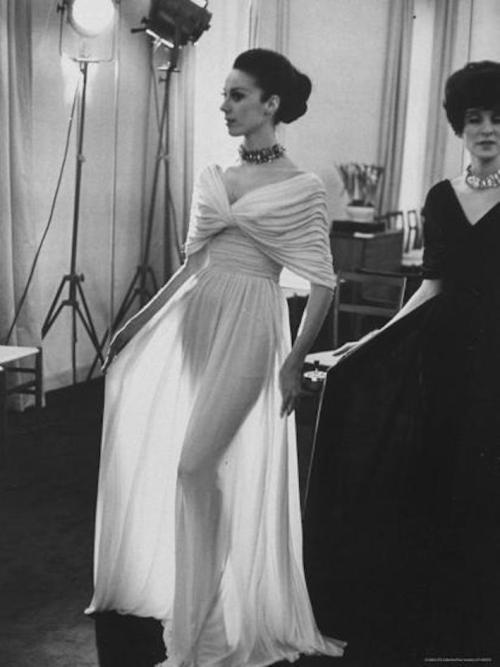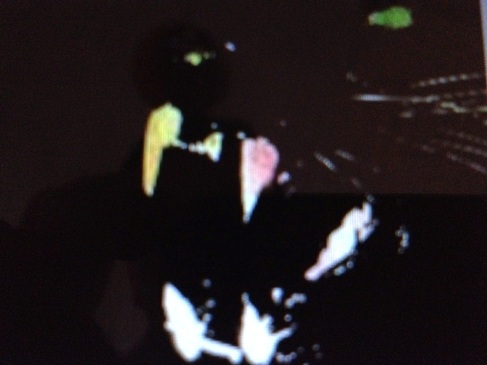
I recently picked up an old extrait de parfum of Vivre by Molyneux at the junk shop in Zushi for just three hundred yen ( £2.27 ). Not in prime condition, the top notes faded, perhaps, but still alluring – a mixture of dark and light. Inscrutable. I couldn’t quite resist it. The perfume intrigued me : it has a pull.
Far less well known that other famous couturiers of the time such as Balmain, Balenciaga, Givenchy and Madame Grès, Edward Molyneux (1891 – 1974) was a British designer who later settled in Paris and became known by those in the know for his ‘impeccably refined simplicity’. According to historian Caroline Milbank, Molyneux was the designer ‘to whom a fashionable woman would turn if she wanted to be absolutely right without being utterly predictable in the Twenties and Thirties’. His skills were thus much appreciated by the likes of Greta Garbo, Marlene Dietrich, Vivien Leigh as well as European royalty. A perfume line was launched with 1932’s debut fragrance, Le Chic.







I first heard a mention of Vivre in the original French version of Luca Turin’s Parfums: Le Guide, first published in 1992 but which I never laid eyes on until around 2006, when Helen sent me a copy in the post. I would feast my eyes on it passionately instead of preparing for lessons in the teachers room, hiding it under other papers; exhilarated (this was the first time I had ever really read anything meaningful and beautiful like this about perfume and it excited me to the core, the marriage of the olfactory, and the linguistic as a way of conjuring a hidden world. It wasn’t very long afterwards that I embarked on similar journey myself, putting pen to paper in my first perfume that I ever wrote – Mitsouko, in 2008), but I still remember the sheer joy of being able to read about a topic that hitherto I had experienced, profoundly, but not seen expressed. Many of the perfumes in that original guide were not possible for me to smell; either discontinued or reformulated into unrecognisability. Lost in France. But while the exacting and very poetic descriptions of perfumes I did know in the book always produced a delicious frisson of recognition, the perfumes I had never smelled, nor was ever really likely to, produced even stronger a yearning in me; a vaguely masochistic ache of desire.
Assessing the nobility of this perfume – one of the writers on Fragrantica describes Vivre as having an ‘incandescent elegance’, with a smell as cold as marble on the skin of her mother – I thought it would be interesting to ask New Hampshire based vintage perfume collector and connoisseur Gabrielle Baechtold about her thoughts on this enigmatic perfume – which I happen know is one of her favourites. It also turns out that Gabrielle was actually wearing Vivre vintage parfum, the very time that she met Luca Turin in person.
The Black Narcissus:
I love the idea that you met Luca Turin while wearing Vivre and that he told you it was one of this favourite perfumes. How did this come to pass? Where did you meet him? Did he smell it on you directly and comment on it (knowing what it was?) What made you choose that perfume for that encounter?
Gabrielle:
Meeting Luca Turin happened through my friend Mark Behnke, who has his own blog Colognoisseur. He is a research scientist by trade and was in contact with Luca Turin, who at the time was doing research work in a Boston area university. There were three of us, along with Mark who met Luca Turin and Tania Sanchez; Ida, who you know ; Catherine Bromberg, from BaseNotes and myself. We all met at a cafe in either Cambridge or Somerville Massachusetts, near where Luca was doing research. I think I wore Vivre that evening because of a comment he had written about it on his on-line blog. It reinforced my love for the scent. I let him smell my wrist during the conversation and said it was Vivre and he waxed poetic about it for a few minutes and lamented it being extinct. He said it smelt very nice on me, again solidifying my fragrance choice.
BN:
How did you first come across Vivre?
G:
I had first heard about Vivre by looking through my mother’s magazines and seeing the advertisements for the scent. My first interaction with the scent came years later at the little shop I told you about, Colonial Drug, where I would buy all my Guerlains. I have to say, I was not in love with it upon first smell; I was pretty much a Guerlain cultist at the time, but I eventually purchased a small extrait of it and grew to love it over the years. Aldehydic, floral chypres had not my been my go to at the time, but as the years went by, I grew to passionately love them and for some reason I am wearing them quite often during quarantine now.


BN:
Me too. I find that I am wearing aldehydes a lot during the lockdown as well. There is just something so otherworldly and yet comforting about them; you can disconnect from the harshness of reality. A noblesse of refuge.
In terms of Vivre, I don’t quite know how ravaged the bottle I got the other day is (the hyacinth notes have substantially gone ) but I can still feel that there is something quite distinctive about this perfume. It isn’t quite the usual soft floral aldehyde in the manner of Detchema, and yet it isn’t the leather chypre like Givenchy III etc : it is ALMOST like a hybrid in between. Would you agree? The perfume’s notes include artemisia and coriander; a fresh green leaf accord; incense and myrrh too, which are unusual in a floral aldehyde. Would you say there was any correspondence in scent construction between Vivre and, say, Nina Ricci’s sententiously brooding floral aldehyde, Farouche? I personally feel some similarities.
G:
It is funny that you mention if there were any correspondence between Vivre and Farouche – one of my all-time favourites – and there is. They both start out with a big note that announces their arrival, but slowly they start to warm up to you and open up and become much more intimate. Kind of like the punk-rocker with spiked hair you meet, who then confides in you she likes reading Baudelaire in a gauzy silk dressing gown. I would definitely say Vivre and Farouche are cousins, either first or at least once removed.
BN:


1. You will love me. I know it. 2. You will be jealous. I know it. 3. You will take me to Venice. I know it. 4. You will never leave me. I know it.
I KNOW WHAT LIVING IS.
I know what it means to live…..

BN: Despite the elegant refinement of this perfume, I can see how the words in this seventies’ advertisement (You will never leave me ……...a self-knowing lover’s imperious command) definitely correspond to the smell of the perfume itself. There is something quite compelling, obsessive about Vivre; I think possibly from the vetiver and leather and the aridity of the oakmoss/sandalwood/myrrh base but without the bitterness of some of the more acrid heavier chypre leathers. This treads a deliciously fine line.
How do you personally feel when you wear Vivre?
G:
When I wear Vivre I feel alive, which is pretty ironic, considering the name, but it does make you feel aware of the moment you are in. There is a juxtaposition in the scent, between the sparkling notes and the dirty floral note. Almost as if you had put a touch of Chanel N°5 on then went out and did some serious gardening; getting your forearms all dirty and smeared with flower nectar. There is something oddly compellingly and comforting in the fragrance, something that makes you want to keep sniffing at your wrist. Something warm and nurturing. This could just be my take on it, though, because my Mama was fond of similar scents and it reminds me of her “skin scent”.
BN:
I agree, though. Calming, yet also somehow slightly unsettling.
Gabrielle, you are a great lover of vintage perfume – your collection sounds truly magnificent. Do you still hunt down vintage bottles of Vivre?
G:
I only wear 70’s vintage Vivre. Molyneux first released a scent named Vivre in the 30’s, but that was completely different. They also just released a newer version a few years back and that is utter garbage. The 70s version is the perfect one. I always try to hunt down vintage bottles, especially of the extrait, which can be quite pricey, but I love it.
Another thing I can say about Vivre, after wearing it now for most of the day, is that it develops into the most wonderful melange of hothouse flowers. I had never really noticed that aspect of it before. It is truly sublime.
BN :
I hope one day that I can smell it on you in person!
A few years back, I remember you once very kindly sent me a very generous spray sample of another forgotten classic from the house – Fȇte (1962). Can you tell us more about that perfume and any others you might have by Molyneux?


G:
I adore Fête so much. It’s like the lovechild of Mitsouko and Femme with a quick wit about her. Truly and underrated gem. Then again Molyneux as a whole is such an underrated house. I own Le Numéro Cinq by them which was more popular than Chanel’s 5 at one point, but Chanel’s N°5 won in the long run and Molyneux had to change the name to Le Parfum Connu so as to save face. Le Numéro Cinq is a gorgeous scent, aldehydic floral, but with a deep and enticing heart. I also own Le Chic, Rue Royale, Gauloise, Quartz and Initiation by Molyneux all of which are exquisite. Gauloise in particular is a stunner, but each is a treasure.



BN:
Gorgeous.
Thank you so much, Gabrielle.
G:
My absolute pleasure.















































